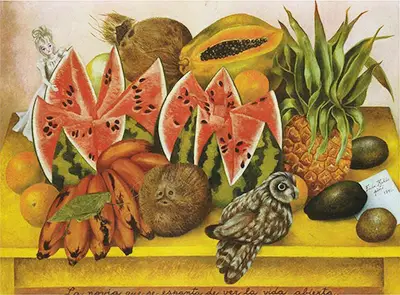The papaya fruit is opened up to highlight the female genitalia while the bananas symbolise the male version. Kahlo includes an owl to represent one such bird that lived in the bride’s patio. Though the painting is dated 1943, Kahlo created it in 1939. At the time, she did not include the little bride hiding in the left. Also, the papaya was not split open, and Kahlo had not added the bright colours or erotic undertones highlighted on this still life painting. The 1939 piece was a simple unsigned still life fruit and an owl. Frida had bought the bride doll at a flea market in 1939 but only included it in painting in 1943 when she also signed and dated it.
For most critics, Kahlo’s use of still-life objects in her paintings portrayed an unusual symbol for her nationalist sentiment. They were oblivious of Kahlo's intention to use the fruits as a symbol of the pride she had in her country. She used locally grown produce like papaya, bananas, melon, coconut and prickly pears as a deliberate political stance. Still-life paintings were also a form of indirect self-portraiture. In this case, she uses ripe forms of fruits and splits one of them to reveal its fleshy interiors that are suggestive of body parts and a hidden form of eroticism.
As mentioned earlier, Kahlo painted this piece in 1939. The painting did not have several features that portrayed the erotic undertones of the 1943 art. All such characteristics indicate Kahlo's use of Surrealism style on her 1940s paintings. Though she did not describe herself as a Surrealist, she was slowly absorbing those influences.
Before creating this still life, Kahlo had painted a similar piece called Fruits of the Earth in 1938. In this painting, she used fresh corn herbs and dried-up husks together to depict the cycles of life. Ironically, Frida had painted this piece for Paulette Goddard, Diego's mistress. She then painted Pitahayas in the same year, a piece that echoed the theme of mortality explicitly.

